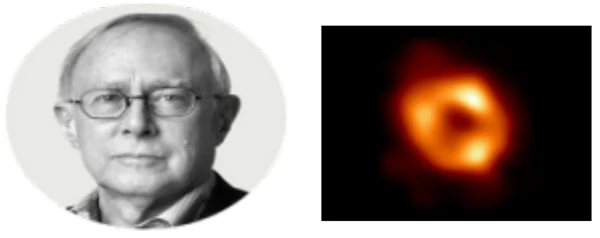The Event Horizon Telescope has once again caught sight of the “unseeable.”
Leia o texto e responda às questões 59 e 60.
The Milky Way’s Black Hole Comes to Light
The Event Horizon Telescope has once again caught sight of the “unseeable.”
By Dennis Overbye
The first direct image of Sagittarius A*, the black hole at the center of the Milky Way.Credit...Event Horizon Telescope Collaboration/National Science Foundation
Published May 12, 2022 Updated May 13, 2022
Astronomers announced on Thursday that they had pierced the veil of darkness and dust at the center of our Milky Way galaxy to capture the first picture of “the gentle giant” dwelling there: a supermassive black hole, a trapdoor in space-time through which the equivalent of four million suns have been dispatched to eternity, leaving behind only their gravity and¹ violently bent space-time.
The image, released in six simultaneous news conferences in Washington and around the globe, showed a lumpy doughnut of radio emission framing empty space. Oohs and aahs broke out at the National Press Club in Washington when² Feryal Özel of the University of Arizona displayed what she called “the first direct image of the gentle giant in the center of our galaxy.” She added: “It seems that black holes like doughnuts.” Dr. Özel is part of the Event Horizon Telescope project, a collaboration of more than 300 scientists from 13 institutions that operates an ever-growing global network of telescopes that compose one large telescope as big as³ Earth. The team’s results were published Thursday in The Astrophysical Journal Letters.
“I met this black hole 20 years ago and have loved it and tried to understand it since,” Dr. Özel said. “But⁴ until now, we didn’t have the direct picture.”
In 2019, the same team captured an image of the black hole in the galaxy Messier 87, or⁵ M87. That image, the first ever taken of a black hole, is now enshrined in the Museum of Modern Art in New York. “We have seen what we thought was ‘unseeable,’” Sheperd Doeleman, an astronomer at the Harvard-Smithsonian Center for Astrophysics, said at the time.
Astronomers said the new result would lead to a better understanding of gravity, galaxy evolution and how even placid-seeming clouds of stars like our own majestic pinwheel of stars, the Milky Way, can generate quasars, enormous geysers of energy that can be seen across the universe.
Disponível em: <https://www.nytimes.com/>. Acesso em: 25 maio 2022.
UNIFOR 2022.2 - QUESTÃO 59
Com base na leitura do texto, analise as afirmativas.
I. Sagitarius A* é o nosso buraco negro supermassivo, com uma massa de quatro milhões de sóis, localizado no centro da Via Láctea.
II. O projeto envolve 300 cientistas de 13 instituições que operam uma rede de telescópios.
III. A primeira foto do buraco negro da nossa galáxia foi obtida em 2019 e está no Museu de Arte em Nova York.
IV. A primeira imagem foi transmitida simultaneamente para seis conferências de notícias em Washington e no mundo.
V. Quasars são enormes gêiseres de energia que podem ser vistos através do universo.
É correto apenas o que se afirma em
(A) I, IV e V.
(B) I, II e IV.
(C) III, IV e V.
(D) II, III, IV e V.
(E) I, II, III, IV e V.
QUESTÃO ANTERIOR:
GABARITO:
(A) I, IV e V.
RESOLUÇÃO:
Não temos resolução para essa questão! Você sabe explicar? Copie o link dessa página e envie sua resolução clicando AQUI!
PRÓXIMA QUESTÃO:
QUESTÃO DISPONÍVEL EM:







